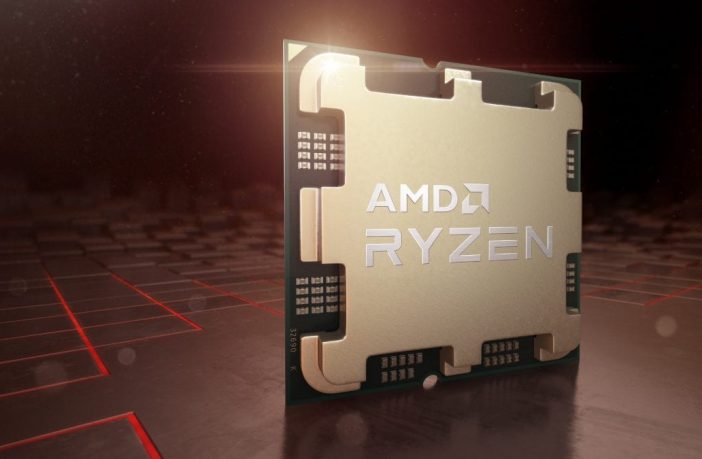
AMD has unveiled the first of its Ryzen 7000 series desktop processors for high-performance gaming and avid PC users. The company says its high-end Ryzen 9 7950X will be the world’s fastest processor for gaming and content creation. These processors are based on the new “Zen 4” architecture and introduce a new platform called AM5, with support for DDR5 RAM and the PCIe 5.0 interconnect standard. The new processors will be available at retail worldwide starting September 27. Pricing for India has yet to be announced, but in the US, the 16-core Ryzen 9 7950X flagship is priced at $699 (around Rs. 55,360 before tax). The 12-core Ryzen 9 7900X will cost $549 (roughly Rs. 43,480) while the 8-core Ryzen 7 7700X has a sticker price of $399 (roughly Rs. 31,600) and the Ryzen 5 7600X will cost $299 (roughly Rs. 23,680).
The new “Zen 4” architecture is claimed to deliver an average 13% improvement in instruction performance per clock cycle over the Zen 3 architecture. branch prediction optimization. Support for the AVX-512 instruction set means improved performance for AI inference workloads.
The Ryzen 9 7950X has 16 cores and 32 threads spread across two “base complex” chips, a boost speed of 5.7 GHz and a base speed of 4.5 GHz, and a total cache memory of 80 MB The Ryzen 9 7900 jumps to 12 cores/24 threads and base/boost speeds of 4.7GHz and 5.6GHz respectively, with 76MB of cache. Both have TDP ratings of 170W. The Ryzen 7 7700X with 8 multithreaded cores runs at 4.5GHz but drops to 5.4GHz, with 40MB cache. The Ryzen 5 7600X with 6 cores/12 threads runs at 4.7 GHz with a boost up to 5.3 GHz and 38 MB of total cache memory. These two processors both have TDP ratings of 105W.
More Ryzen 7000 series models are expected to launch in the future, falling in between these and also filling out the lower end of the stack. Versions with an additional stacked 3D cache are also expected to launch later. It’s likely that AMD will continue to use previous-generation hardware to serve more budget-conscious buyers, especially those who are upgrading and wish to continue using their existing motherboards and RAM.
For the first time, enthusiast-class Ryzen processors will all have integrated graphics capabilities. Rather than a separate set of APUs, AMD has decided to integrate simple RDNA2-based GPUs into the four announced models. While a discrete GPU is still needed for serious gaming, it should help with simple workloads and diagnostics.
Power management is also improved, incorporating several efficiency improvements that were previously targeted at mobile processors, resulting in a 50% reduction in standby power consumption.
AMD used a 5nm TSMC manufacturing process and claims a competitive advantage over Intel’s 12th-gen “Alder Lake” offerings in die area and performance per watt. Single-threaded performance should be better, as AMD points out that Intel’s high core count comes from using multiple less powerful “efficiency” cores. However, Intel’s 13th generation “Raptor Lake” is also expected to be announced soon.
Compared to the previous generation, AMD claims 62% lower power consumption to deliver the same performance, or 49% higher performance at the same power level. At a TDP of 65W, the power scaling can go up to 74%, although the figure drops to 35% at 170W, which is the TDP of the Ryzen 9 7950X.
The new AM5 platform breaks the long-standing socket compatibility of the AM4 platform, which dates back to the first generation Ryzen processor series. This was necessary to support DDR5 and PCIe 5.0 RAM and increase the power delivered by the socket. AMD is moving to an LGA-style package for the first time, with contact pads on the CPU and pins in the motherboard socket. However, the cooler support has not changed, so existing coolers can continue to be used without any adapters. AM5 will continue to be supported until at least 2025, according to AMD.
Enthusiast-class motherboards based on AMD’s X670 Extreme and X670 chipsets will be available at launch. The mid-range B650 Extreme and the previously unannounced B650 will follow in October. These will vary in feature level, with only the top-end X670 Extreme supporting PCIe 5.0 for discrete graphics as well as storage.
The company also unveiled AMD Expo, a new platform-level feature to optimize DDR5 RAM timings and latency, which is supposed to improve gaming performance and make overclocking easier. Finally, AMD CEO Dr. Lisa Su unveiled a demo of an upcoming Radeon GPU based on the RDNA 3 graphics architecture. Performance per watt is said to be 50% better than the current generation Radeon RX 6000, and these GPUs are expected to launch later in 2022.
Tech




